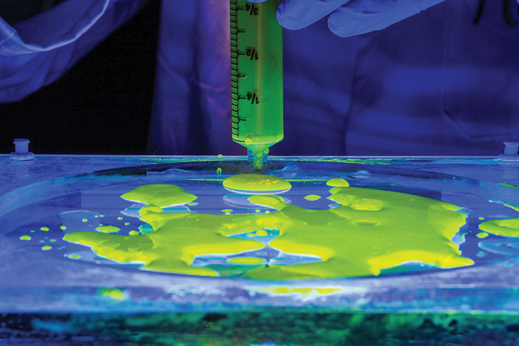Wondering over Spilled Water
Researchers figure out why puddles have edges.
When you spill a drink onto a tabletop, the liquid spreads out and then stops, leaving a puddle with a sharp boundary. The formulas scientists use to describe such a fluid flow, however, say that the water should just keep spreading endlessly. Everyone knows that’s not the case—but why? Understanding the answer is essential for processes from lubricating gears to sequestering carbon dioxide.
Ruben Juanes, an associate professor of civil and environmental engineering, along with graduate student Amir Pahlavan, research associate Luis Cueto-Felgueroso, and mechanical engineering professor Gareth McKinley, PhD ’91, recently figured out the answer to this long-standing conundrum.
“The classic thin-film model describes the spreading of a liquid film, but it doesn’t predict it stopping,” Pahlavan says. It turns out that the problem is one of scale: “What’s actually stopping the puddle is forces that only act at the nanoscale,” he explains. And even though these forces are minuscule, their effect changes the liquid’s behavior in a way that is obvious at a much larger scale.
This story is only available to subscribers.
Don’t settle for half the story.
Get paywall-free access to technology news for the here and now.
Subscribe now
Already a subscriber?
Sign in
You’ve read all your free stories.
MIT Technology Review provides an
intelligent and independent filter for the
flood of information about technology.
Subscribe now
Already a subscriber?
Sign in
These intermolecular forces, which drop off sharply with distance, only play a role on objects that are extremely close together. Near a puddle’s edge, the film of liquid becomes vanishingly thin and the top and bottom surfaces are almost touching. There, the liquid-solid and liquid-air interfaces are close enough for the intermolecular forces to affect them. “These are the missing intermolecular forces in the macroscopic description,” Pahlavan says. While it was known that these forces needed to be accounted for, previous proposed models had failed to consistently match the experimental observations. By factoring in the nanoscale modification of the surface tension near the puddle’s edge, the MIT researchers’ model resolves many of the inconsistencies in the previous models.
The principles involved affect many other situations where the ability to calculate how a fluid will behave can have important consequences, from lubrication to cooling systems. For example, for carbon sequestration—removing carbon dioxide from fossil-fuel emissions and injecting it into underground formations—understanding how the fluid will spread through pores in rock is essential to predicting how stable this type of storage may be.
“You start with something very simple, like the spread of a puddle, but you get at something very fundamental about intermolecular forces,” Juanes says. “The same process, the same physics, will be at play in many complex flows.”
